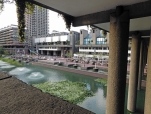Poetry of Brutalism

This architectural style of the period between 1950s-1970s is called “brutalism” or “neobrutalism”. However, two different names should not confuse you, because in fact they mean the same thing. The starting point of brutalism is the work of a married couple of architects from UK, Alison and Peter Smithson. It was they who first used this term in their theoretical notes and articles, describing their own architectural projects of the early 1950s. Le Corbusier was also involved in the development of brutalism. Thus, the architect described the technology of processing exterior surfaces of buildings, applied by him in many buildings of the postwar period, with a French term “béton brut” or “raw concrete”. It was this term that later formed the basis for the name of the style “brutalism”.
The influence of Le Corbusier on the development of brutalism in Great Britain was not only theoretical, but also quite practical. Despite the fact that the French master of Swiss origin never built a single building in this country, his projects in other parts of the world had a direct impact on the British brutalists. For the latter, his work from simple red brick (Jaoul’s houses on the outskirts of Paris), experiments with “collective housing” (“living unit” in Marseille), his use of reinforced concrete, became a symbol of hope for the creation of new, post-war architecture.
It is curious that the Smithson couple, who were part of the Team-X group, were Le Corbusier’s opponents by CIAM (fr. Congrès International d’Architecture Moderne or the International Congress of Modern Architecture), who called on the international organization to abandon the mechanistic approach of early modernism, which was supported by the French by origin master, in favor of a humanistic view of architectural design. The brutalist architecture, in their opinion, had to “ resist the society of mass production, trying to extract strict poetry from complex and powerful acting forces.”
 Text: Elizaveta Klepanova
Text: Elizaveta Klepanova
The full version of the article can be read in our printed issue, also you can subscribe to the web-version of the magazine


